I may receive a commission if you purchase through links in this post. I am not a doctor; please consult your practitioner before changing your supplement or healthcare regimen.
Fermented Peanut Butter is a great homemade recipe that allows you to eat peanut butter without aflatoxins. Fermenting also reduces oxalates, adds probiotics and makes the nutrients in peanut butter more bioavailable.
If you choose to ferment with Valencia peanuts, you’ll also have a peanut butter lower in PUFAs and higher in monosaturated fats.
I hope you love this tangy condiment as much as we do! Terrific in the usual settings with jam, honey or chocolate, but also good in savory foods.
This recipe is great for many diets, including Ancestral, Gluten-free, Keto, GAPS and Vegan.
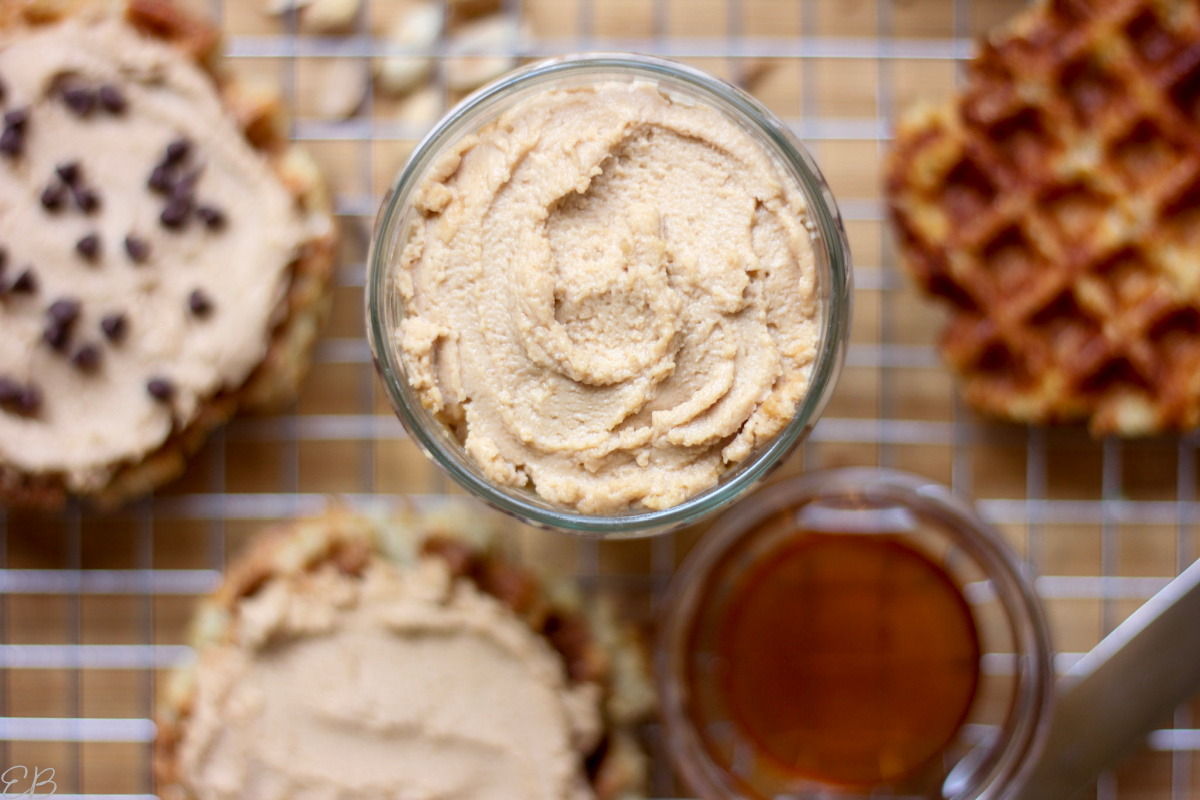
What are aflatoxins in peanut butter
Aflatoxins are a family of toxins produced by specific fungi that are found on certain crops. Grains, nuts, peanuts and dried figs are considered some of the worst sources.
Aflatoxins are very dangerous and not at all safe or healthy to consume on a regular basis.
You can read more about aflatoxins in peanut butter and how much the leading brands have here.
When people avoid peanut butter, aflatoxins are one of the main reasons.
However, when peanut butter is fermented, it has zero aflatoxins. Fermentation has been proven to eliminate aflatoxins, but I also sent my Fermented Peanut Butter to a lab that specializes in this kind of testing to be sure.
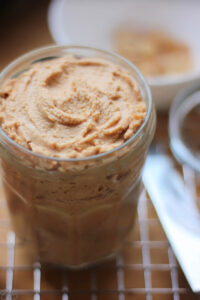
Ingredients in Fermented Peanut Butter
It is possible to make Fermented Peanut Butter from peanuts or from store bought peanut butter.
The better choice is to make it with peanuts, because you are then controlling your ingredients and processes better. Most store bought peanut butters may be rancid or have other quality control issues.
Therefore, this recipe uses peanuts.
To make Fermented Peanut Butter with peanuts, you’ll need:
- peanuts — Ideally, buy organic peanuts that are raw, and then roast them yourself, which I show how-to in the Notes section below the recipe. (Optionally, you may also sprout them first, which includes soaking them overnight and then dehydrating them.) See more below the recipe on which peanuts to buy.
- water — This ingredient is surprising but important. Without water, the probiotics get trapped in the matrix of peanut butter fat and can not (and will not) proliferate. Adding water also makes the peanut butter creamy and little less peanut-y in flavor, which allows the tangy flavor to balance it.
- sea salt — Optional.
- probiotic — Use a probiotic that you know is alive and you know works well for inoculating fermented foods, like this one. Or, use a vegan probiotic designed to make dairy-free yogurt.
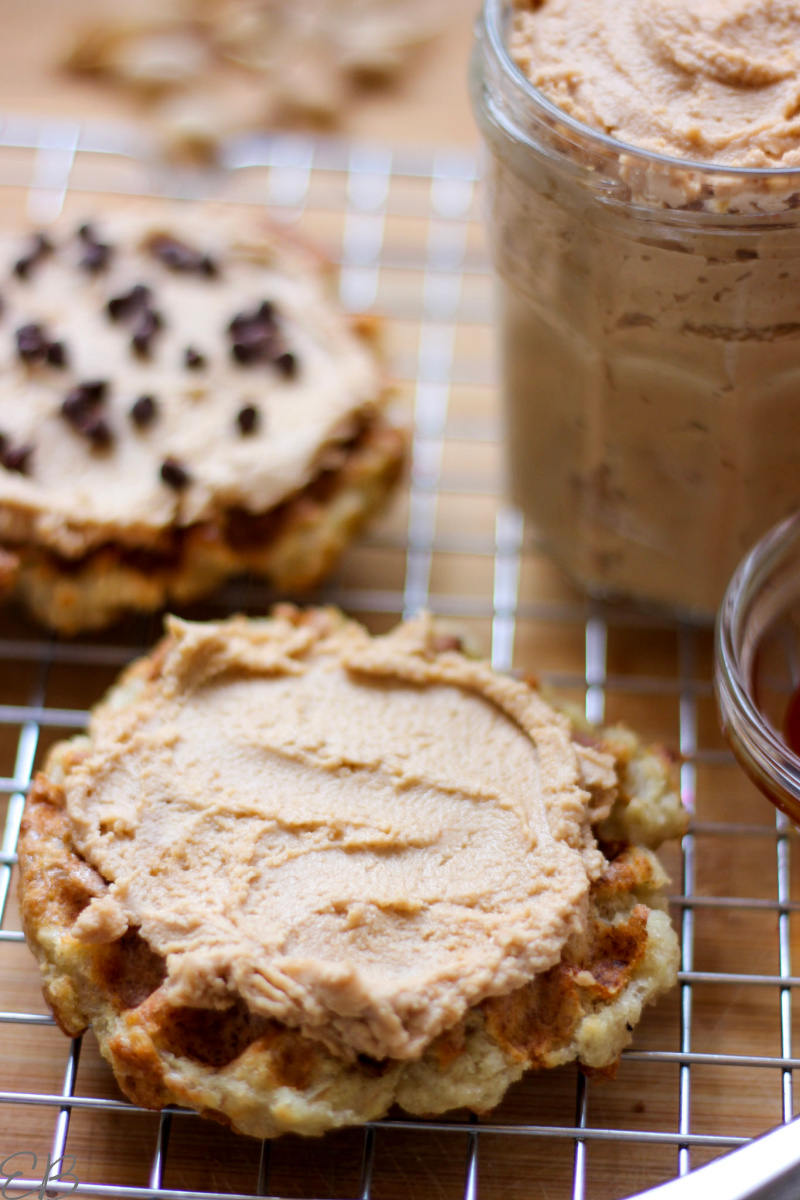
How does Fermented Peanut Butter taste
I find it pleasantly tangy, almost like it has a little lemon juice added, or similar to yogurt.
It will not be to everyone’s liking, especially if you are expecting to taste a JIF or Skippy type peanut butter.
But if you are used to learning to like new things and enjoy natural flavors, you’ll find it quite good. Also, if you typically like yogurt or tangy foods, I think you’ll like it.
Most who enjoy natural foods and yogurt will find it very delicious and satisfying.
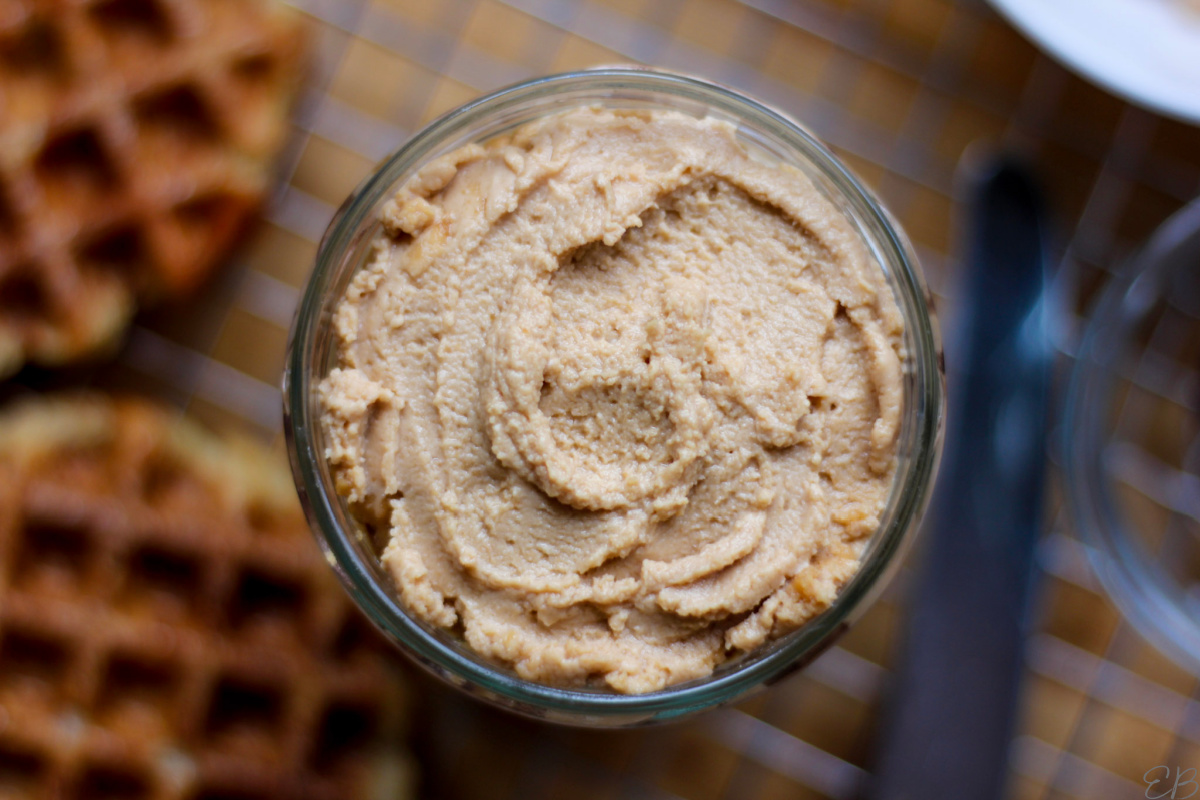
How to make Fermented Peanut Butter
Making Fermented Peanut Butter is an easy and fast process:
- Place peanuts in food processor. Process until peanut butter forms.
- With motor running, gradually add in water until it’s fully incorporated.
- Remove lid, and add probiotic. Blend again just briefly.
- Move peanut butter to fermenting container, and cover: This can be a jar, yogurt maker or even an Instant Pot insert, if you have the Yogurt setting on your machine.
- Keep in warm steady location, such as a yogurt maker, seed mat or Instant Pot.
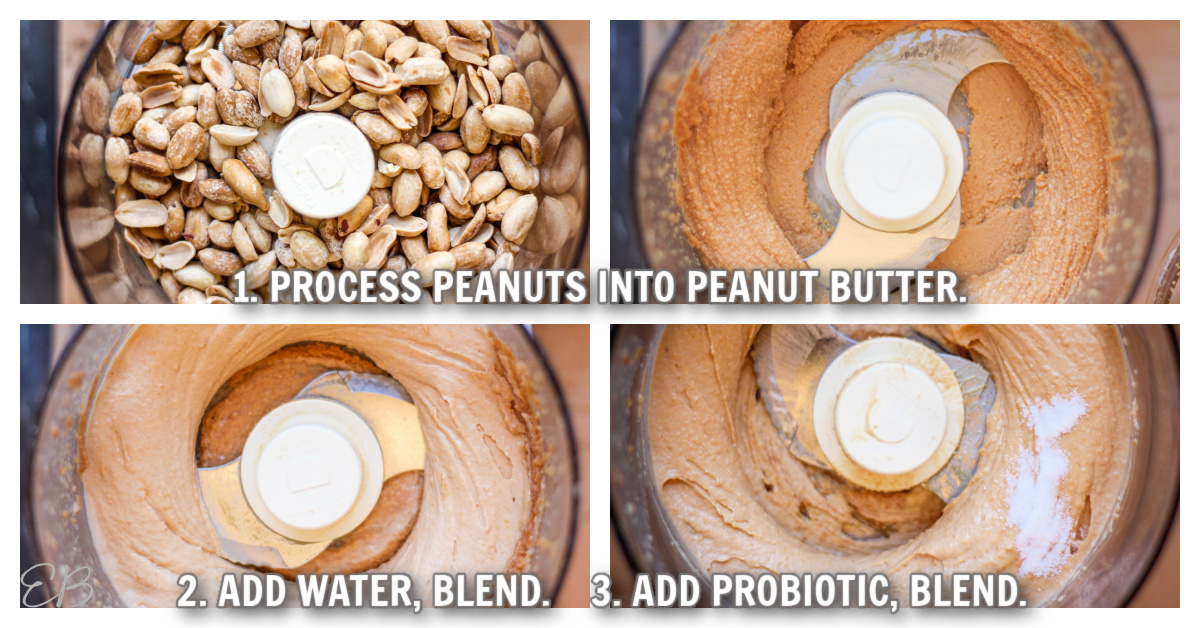
Fermented Peanut Butter recipe
Ingredients
Instructions
- Blend roasted (and de-hulled, if needed) peanuts and optional sea salt in food processor until peanuts become peanut butter.

- With motor running, gradually add water through the feed tube. Blend until water is fully incorporated and peanut butter is creamy. Take off the lid. Use a spatula to scrape the sides and bottom so they get mixed in with the next step.

- Sprinkle in probiotic, and blend just briefly to mix.

- Transfer peanut butter to fermentation vessel or glass jar. Cover loosely. Place in steadily warm location for about 15 hours. (If you have an Instant Pot with a Yogurt setting, you can ferment directly in the insert pot, if you like.) Note: Your peanut butter may have a darker "skin" over the surface after fermenting, which is fine; it's just darker and firmer where it was exposed to the air. This can be stirred in or ignored.

- Transfer to fridge, or eat immediately. Store Fermented Peanut Butter in the fridge for 1 month, or possibly much longer.

Notes
Learn how to soak and "sprout" your peanuts here.
Sprouting raw peanuts simply means to activate them, creating a more digestible peanut. You will not actually see a sprout.How to roast peanuts
- Preheat the oven to 350 degrees F.
- Spread peanuts in a single layer on a large rimmed baking sheet.
- Roast about 10 minutes, until golden brown and glossy with fat.
- Allow to cool fully before processing into peanut butter.
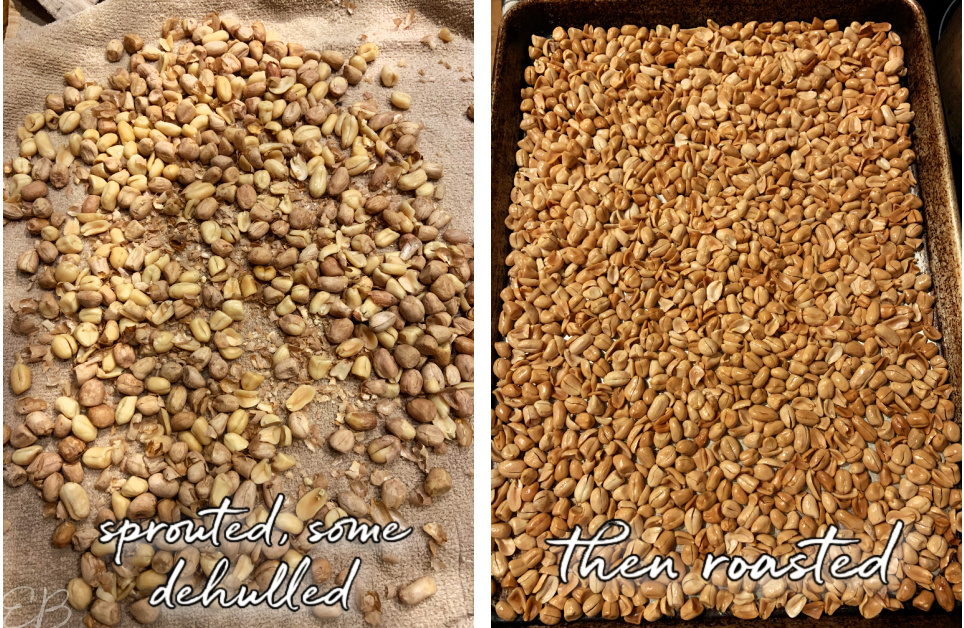
Nutrition
You can Pin this recipe here:
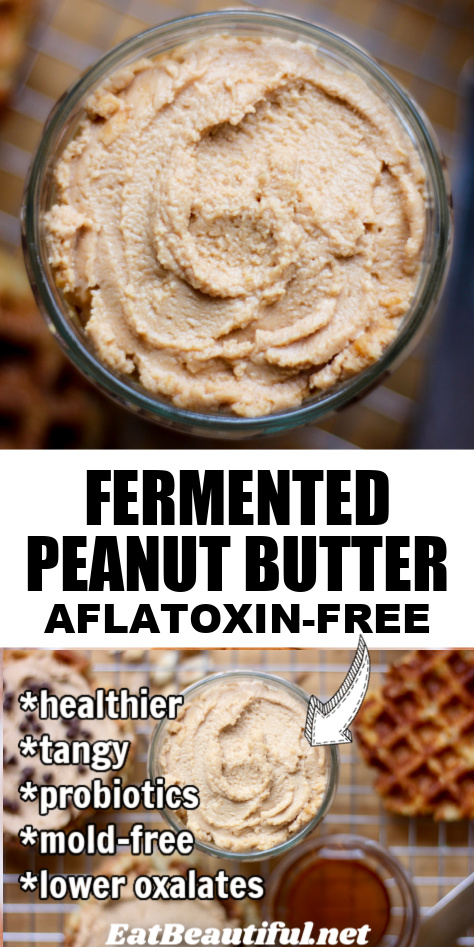
Similar recipes I think you’ll enjoy:
- Fermented Almond Butter
- Fermented Nut Milks (any nut or seed may be used)
- Tiger Nut Yogurt
- Cashew Yogurt
- Fermented Cheesecake
- Overnight Hemp Porridge
- Homemade Macadamia Nut Milk
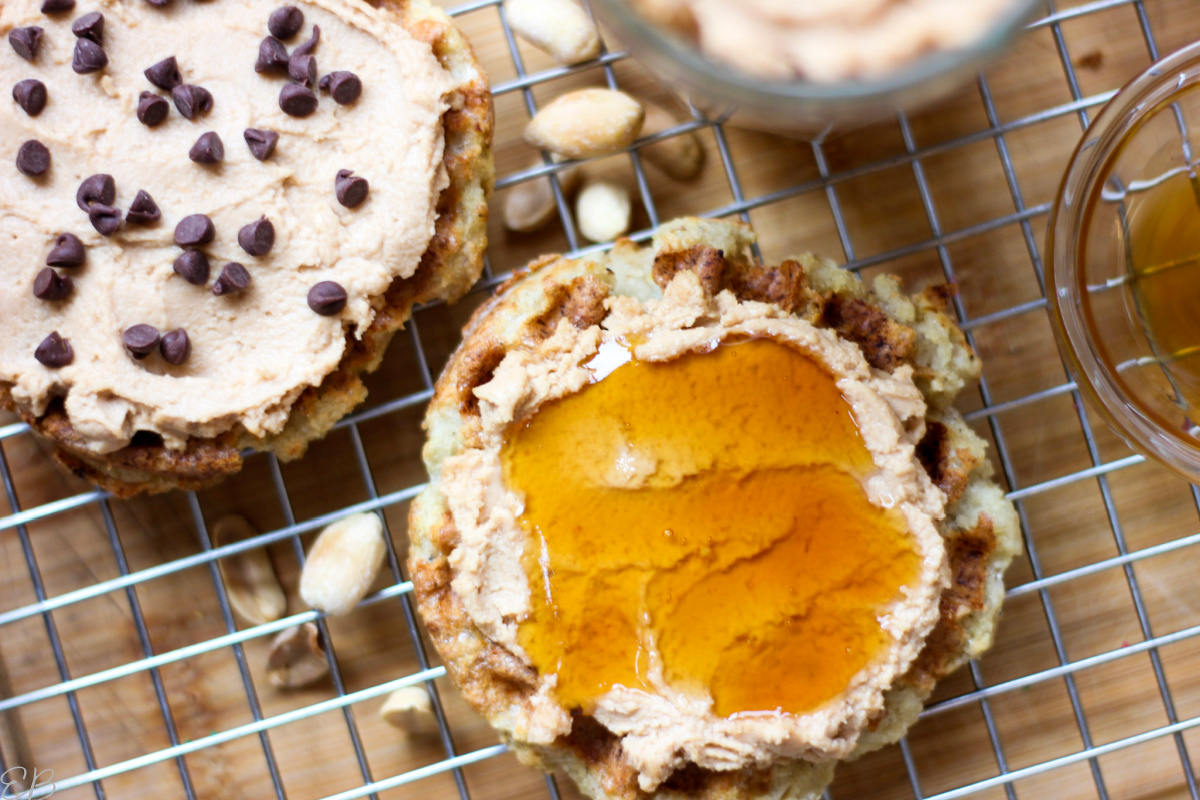
Which peanuts to buy
Firstly, why is it important to buy organic peanuts?
Peanuts are soft, porous legumes that absorb the soil contents which surround them. Grown underground, they absorb pesticides. Conventionally grown peanuts are a heavily sprayed crop.
Oftentimes, they are also grown in regions of high humidity where aflatoxins grow best.
Organic peanuts are often grown in the Southwest where humidity is not a problem. And if you buy Jungle or Valencia, they are often grown on bushes above ground.
I’ll share a few links to good peanut options. All of these are organic and raw. 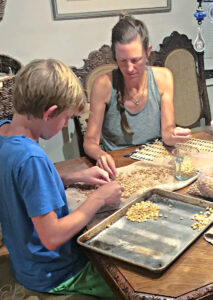
- Raw Spanish Peanuts (need to be hulled) — These are a good option if you plan to soak, sprout and de-hull yourself. To the side here, you can see a photo of me sharing the de-hulling process with my boys, which was actually a lovely activity.
- Raw Jungle Peanuts — I have not yet used these myself, because I bought another variety in bulk. But I look forward to trying these as well. You could probably try and make purely raw fermented peanut butter with this variety of peanut. All others I’d roast first.
- Raw Valencia Peanuts — Lowest in PUFAs, which helps to keep the diet more balanced with omega 3:6 intake.
Note: I specifically do NOT recommend this source, as it tested positive for detectable aflatoxins. Although still very low and surely fermentation eliminates the mold, I don’t trust the product knowing it contains detectable levels.
Are peanuts healthy
Peanuts are high in vitamin E, magnesium, phosphorous, zinc, potassium and calcium.
Fermenting makes all of these nutrients more bioavailable.
As mentioned, if you choose Valencia peanuts, they are also lower in polyunsaturated fatty acids and higher in monounsaturated fats. The fat profile of peanuts makes them a food to eat in moderation.
Lastly, peanuts are high in protein and very low in carbs. This makes them a great snack food, and makes Fermented Peanut Butter a healthy condiment for most people, including those on a Keto diet.
Additional Sources
https://cdn.intechopen.com/pdfs/22035/InTech-Methods_for_detection_and_quantification_of_aflatoxins.pdf
http://www.sixwise.com/newsletters/04/12/12/peanuts-most-are-carcinogenic–amp-pesticide-contaminated-but-there-are-safe-sources.htm
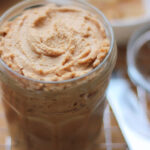





Suzanne says
Nuts.com to purchase wonderfully delicious and organic Jungle peanuts
The following sites for Jungle peanut butter:
https://gonegreenhemp.com/
americanwildfoods.com
vivapura.com
Megan says
Thanks, Suzanne, for these suggestions.
Monica says
I wonder if using other nut butters instead of peanuts is possible – like almond?
Megan says
Hi Monica, yes! But I’m also about to publish a Fermented Almond Butter (or any nut can be used!) recipe, so that might be more accurate and helpful for you. 🙂 Here’s that recipe: https://eatbeautiful.net/fermented-almond-butter-recipe/
ChihYu says
Thank you for this easy to follow recipe! Always looking for ways to add more fermented foods to my diet; peanut butter is one of my favorites! Can’t wait to enjoy!
Megan says
Yay, ChihYu, you’re welcome, and I’m so glad it’s a fun recipe you’ll try. I hope you love it!
Lisa Lam says
Thank you for your recipe. Can I use fermented vegetable brine as probiotic to ferment peanut butter. I love roasted peanuts and have been wanting to ferment peanuts for a healthy version.
Megan says
Hi Lisa, you’re welcome. Yes, you sure can! Sounds lovely. Any flavor of the veggie brine will likely influence the flavor of the peanut butter, so as long as that’s fine with you, it will surely work well.
jennifer says
Great tip about the Valencia peanuts! I have pinned and am making this month — thank you!
Megan says
Great, Jennifer, I’m glad it’s helpful, and enjoy!
Stacey Crawford says
I learned something new today (I had no idea that dried figs also have aflatoxins). I know PB is an issue and I’ve tried to give it up, but I just can’t seem to let it go. Thanks to you, I can now make a healthier, fermented PB.
Megan says
Great, Stacey. I was surprised to learn about figs as well. And we, too, have had such a hard time giving up peanut butter. I’m happy you’ll make and enjoy fermented peanut butter now! 🙂
Donny says
This is fascinating! And my IP does have a yogurt setting which I never use but now I have to try it. Thanks for all the info!
Megan says
You’re welcome, Donny. I hope you have fun with the easy process and love your fermented peanut butter! 🙂
Natalie Klein says
Hello! I want to try this recipe, but I can’t seem to find organic Valencia peanuts anywhere!. Do you have a place that you recommend purchasing them?
Thank you!
Megan says
Hi Natalie, hi and sure ~ there’s a sourcing of peanuts section in the post, at the very end, that you must have overlooked, called Which Peanuts to Buy. But happy to link here: https://nuts.com/nuts/peanuts/organic-blanched.html Enjoy and best!
Daniel Aguas says
Is there a natural probiotic that I can use like kefir?
Megan says
Yes, water kefir would be better than kefir, because the dairy of kefir will change the outcome. Or whey would be good to use. If you do this, any liquid probiotic food will replace some of the water in the recipe. I would use 2 Tablespoons whey, and sub that for 2 of the Tablespoons of the water. 🙂 Great question.
Judy Evans says
This is wonderful! Thank you! I have fermented many things for decades, but never thought about peanut butter. I am eating more strictly these days for my health and extremely careful about anything with toxins, so peanut butter–which I love–was out of the question. I used organic roasted peanuts I had from Azure Standard. Rich and savory–i had a bit with breakfast.
Megan says
Hi Judy, my pleasure, and I’m SO glad you enjoyed the recipe! Yes, rich and savory; I like that. Great that have the good bulk source for organic peanuts, too. 🙂 Blessings!
Carol McCarthy says
What do you mean by d-hulled peanuts? Do you include the skin or just the shell?
Megan says
Take off the shell and the skin. De-hulled refers to the skin.
Kirsten Murray says
Do the Valencia peanuts from nuts.com need to be hulled? We have a couple athletes eating a lot and I need to set myself up with as simplified of a process as I can! ????
Megan says
Hi Kirsten, they have their skins on, so may not be your best product option, to avoid having to hull them. The skins should at least mostly be removed before making peanut butter, sorry!
toma says
Thanks a lot for the detailed recipe!
Is it possible to use the rye starter which I use for making sourdough bread as a probiotic?
Megan says
Hi Toma, my pleasure. I’m sorry, not in this recipe.
Julia says
Hi I’m wondering if fermenting in the salt water brine instead of probiotic will also get rid of the aflatoxins mold? And if so would you just follow the same instructions but add the salt water and let it ferment instead of the probiotic starter?
Thank you,
Julia
Megan says
Hi Julia, no, because peanuts don’t have the beneficial bacteria present that raw vegetables do. You need the probiotic.
Julia says
Ok thanks so much!! Do you think it needs to have that much water in it or could it be less? I didn’t find it to taste very good it was really bland so just wondering if you could use less water?
Thank you,
Julia
Megan says
Hi Julia, sure. You’ll see as you add water that you’re just adding enough to get the right texture that’s a little creamy, not too sticky or oily. You can also add sea salt to taste, and the lemony flavor should help it not be bland.
Julia says
Hello I’m also wondering if the peanuts can be sprouted first then fermented in the salt water brine to get rid of mold? And if so have you done it and does it taste ok? Thanks so much,
Julia
Megan says
Hi Julia, no, I would not do this.
Wanda Fay Schneider says
Does fermenting foods reduce their lectin content?
Megan says
Hi Wanda, yes, it does.
Rachel C says
Can you use either the low or medium setting on the instant pot to ferment, or do you recommend one over the other. I’ve used both for making yogurt.
Megan says
Hi Rachel, you can certainly use any setting you’ve used for yogurt, so the Low one should be fine and good, or possibly the Medium. Unfortunately, IP models vary a little, so I haven’t used my buttons in that way, but it sounds great if you’ve used them for yogurt making.
Amber says
Hi, I’m wondering if yogurt with a live culture could be used to ferment peanut butter. Thank you!
Megan says
Hi Amber, yes, but it will add components that will age and go bad, so you’d need to eat up the peanut butter sooner. Happy to help!
Ana says
I am absolutely delighted to have found this information. i am ready to ferment peanut butter as it was one of my fave snakes along with bananas. Question: for the live starter culture, could I use say raw apple cider vinegar or raw peach vinegar? If so, in what quantity. i am starting my experiments with the Trader Joe’s brand peanut butter to test. Thanks!
Megan says
Hi Ana, great! No, I wouldn’t use those two as starters to inoculate, sorry. I would use the suggestions in the recipe. This is the probiotic I’m using and liking the best right now: https://amzn.to/3SNTI74 It works great!
Julie Jachens says
Hi! I am excited to try this! I was wondering if any probiotic would do? I have California Gold lactobif blend…would this work?
Megan says
Hi Julie, most likely, but sometimes probiotics that contain prebiotics do not work; it depends. You could try and see…
Julie says
Thank you! I don’t think it contains prebiotics so I will give it a try. Would there by an obvious sign that it hasn’t worked?
Megan says
If it works, it will taste almost lemony. That would probably be the best thing to watch for, is success. 🙂